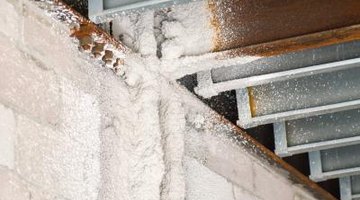What Is the Yield for a Barrel of Spray Foam Insulation?
Spray foam insulation is a method of insulating small or complex areas where batt, roll or foam board insulation would not fit properly. Spray foam offers a convenient way to apply insulation that comes in a liquid form and which then expands to fit any area required. Do-it-yourselfers will need to calculate the yield for each barrel of insulation needed for insulating their homes.
About Spray Foam Insulation

Spray foam is available in a number of compounds that have different characteristics. Cementitious, phenolic, polyisocyanurate or polyurethane materials are widely available, according to the U.S. Department of Energy’s EnergySaver website. The insulation compound is combined with a foaming agent that expands and hardens as the material cures. Slow-curing foams can flow over obstructions and expand gradually to fill space in walls and around home utility equipment. The polyurethane type of spray foam may be closed cell or open cell. The open cell is less expensive but has a lower R-value, that is, the amount of resistance to the transfer of heat. Open-cell polyurethane foam has an R-value of 3.5. Closed-cell polyurethane has an R-value of 6.0.
Using Spray Foam Insulation
Spray foam insulation may be in a can or in large containers that are applied with specialized equipment. Generally, spray foam is done by contractors, but the move toward products that can be used by do-it-yourselfers is becoming more common. Many suppliers offer spray foam insulation “kits” that contain the foam, as well as the equipment required for installation of the material.
Determining the Amount of Spray Foam
The amount of spray foam needed is determined by the amount of surface area you will cover, not the size of your home. The yield of foam depends upon how thickly it is applied. Generally, the foam is applied in inches. A 55-gallon drum contains about 8 cubic feet of spray foam.
Spray Foam Yield Problems
Spray foam insulation must be handled and stored carefully to prevent hazardous conditions. Temperature can affect the consistency and installation of foam materials. Maximum yield is achieved between 70 and 85 degrees Fahrenheit, according to the FomoFoam website. If temperatures fall below 65 degrees F, the storage area should be heated to prevent a decrease in the yield of the installed foam. Colder temperatures can decrease the yield up to 30 percent because the foam will not expand and will simply run. Tanks should be warm to the touch before use. Do not use an open flame to warm the tank before installing the spray foam. The spray foam does not require special storage during hot weather because higher temperatures do not affect the yield of the material.
Photo Credits
- Jupiterimages/Photos.com/Getty Images
More Articles



